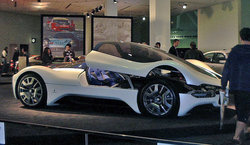Difference between revisions of "Maserati Birdcage 75th"
m |
m |
||
| Line 52: | Line 52: | ||
image:maserati_birdcage_75th 6.jpg | image:maserati_birdcage_75th 6.jpg | ||
</gallery> | </gallery> | ||
| + | |||
| + | |||
| + | {{Maserati S.p.A.}} | ||
Revision as of 07:12, 20 October 2009
The Maserati Birdcage 75th was a concept car created by automobile manufacturer Maserati and designed by Ken Okuyama at Pininfarina. It was first introduced at the 2005 Geneva Auto Show. It was named to honor the classic Maserati Birdcages of the 1960s and Pininfarina's 75th anniversary.
Chassis
The Birdcage 75th is built on the carbonfibre chassis of a Maserati MC12 GT1 race car and shares many components, most notably the engine. The Birdcage 75th is powered by the Ferrari Dino F140 V12 engine of the MC12 and the Enzo Ferrari mid mounted at 65°. The Birdcage 75th's engine has been tuned for racing and as a result produces over 700 brake horsepower.
Bodywork
The car's body was designed, unsurprisingly, by Pininfarina, to celebrate the company's 75th anniversary. The exterior is made of carbon fiber with diffusers at the rear and 2 spoilers that automatically raise at speed. The windshield is made of perspex and extends almost from the front to the back of the car; this is a necessity because of the driver's low seated position - if the windscreen ended higher, they would be unable to see the oncoming road. This visibility problem is compounded by typical concept-car omissions like wing mirrors.
The Birdcage also lacks doors; instead, a bubble canopy composed of much of the front bodywork can be raised, in a similar manner to Saab's 2006 Aero X concept car. However, since the lone demonstrator model lacks air-conditioning or any form of climate control, and the bubble provides substantial 'glasshouse effect', journalists (including evo Magazine's Harry Metcalfe) driving the vehicle were reportedly forced to keep the bubble slightly open on hot days to cool the car's interior.
Interior
The cabin has a Head-Up Display (HUD) which is projected on to a clear panel raised in the centre of the dash. It shows information that would usually appear on dashboard instruments, including the tachometer and speedometer. Also projected is a digital image of Maserati's traditional analogue clock.
Design
According to designer Ken Okuyama the theme of the car is connectivity and "the centre of the steering wheel is a control device that is very similar to a cellphone". The car has a bluetooth headset for mobile phones designed by Motorola and several cameras so that the driver can "share [their] driving experience with others".
Article provided by ItaliaSpeed.com
The new Pininfarina-designed Maserati concept car which was presented last week at the Geneva Motor Show has been awarded the prestigious 'Best Concept' at the show by the highly respected Autoweek magazine.
The Pininfarina Birdcage 75th won ‘Best Concept’ in the 'Editors’ Choice Awards' category of the American magazine, Autoweek. The motivation behind this award was simply “100% passion”. The Piedmont designer’s Birdcage was constructed by Maserati mechanics in collaboration with Motorola.
“I am pleased with this concept car as it represents the best of Maserati spirit, its tradition and its vision of the future”, stated Karl-Heinz Kalbfell, Maserati’s recently-appointed new CEO.
The Birdcage 75th, which is based on the awesome Maserati MC 12 sportscar, is a true 'dream car', which harks back to the days of the 1960s and 1970s when designer's visions were unfettered by constraints that are sadly all to prevalent today. The new concept is named after the highly-successful Maserati 'Birdcage' racer. In its first guise, as the Tipo 60, it appeared at Rouen in 1959, while it went onto claim notable wins, including a double victory in the gruelling Nuerburgring 1000kms.
Pininfarina's concept, built in conjunction with mobile phone company Motorola, is a real, genuine successor to this idea and draws on the original for inspiration so well. Its sweeping, flamboyantly-brushed lines, its slim side flanks, the hinging forward cockpit cover, and its aluminium dashboard and steering column framework, all update the legendary Birdcage's most famous visual assets cleverly for the 21st century.
Visitors to the show have streamed past this gorgeous concept all week, stopping to take in its stunning lines, and take a trip back through Maserati's history.
At the same time as admirers have made this journey, they have also been able to recall an era when automotive designer's were free to pursue their wildest fantasies, and for this last point especially, Pininfarina's team must be warmly congratulated.
Maserati Birdcage 75th
- Maserati birdcage 75th 1.jpg
- Maserati birdcage 75th 2.jpg
- Maserati birdcage 75th 3.jpg
- Maserati birdcage 75th 4.jpg
- Maserati birdcage 75th 5.jpg
- Maserati birdcage 75th 6.jpg
| Maserati | |
|---|---|
| 1950-1969 | A6 | 3500 | 5000 GT | Mistral | Quattroporte I | Sebring | Mexico | Ghibli I |
| 1970-1979 | Khamsin | Bora | Indy | Merak | Quattroporte II | Quattroporte III | Kyalami |
| 1980-1999 | Biturbo | Spyder I | Quattroporte III Royale | Shamal | 220 | 228 | 420 | 430 |Karif | Barchetta | Ghibli II | Quattroporte IV | 3200 GT |
| 2000-present | Coupé-Cabrio | Coupe | Spyder II | Gran Sport | Quattroporte V | MC12 | Gran Turismo |
| Racing Vehicles | 26M · 8C · V8RI · 8CM · 8CLT · 8CTF · 8CL · 6CM · 4CL/4CLT · A6GCM · 150S · Tipo 63 · Tipo 65 · 250F · 200S · 250S · 300S · 350S · 450S · Tipo 61 "Birdcage" · Tipo 151 · Tipo 154 · MC12 GT1 · Trofeo |
| Concept Cars | Boomerang · Birdcage 75th |
| Fiat Group brands | Abarth | Alfa Romeo | Autobianchi | Ferrari | Fiat | Lancia | Innocenti | Maserati |

